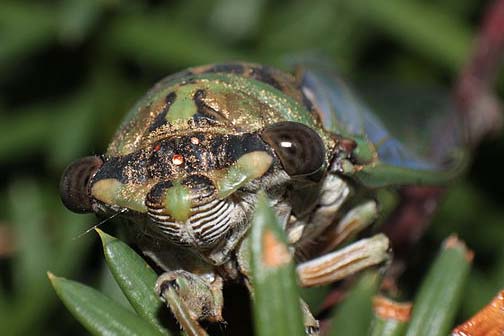Cicadas have been out and singing for a while now. If you live around trees, you may be enjoying their late summer serenade. You also may be finding them on the ground. After they emerge from underground burrows, they molt and enter their adult stage. Then they mate, lay eggs, and die. When you find one, you can examine it to learn more about these big bugs.
Did you know that cicadas have five eyes?
In school we learn that insects have compound eyes, and we use toy bug eye viewers to get a sense of what dragonflies and bees see. But the real picture is a little more complicated. In addition to the pair of compound eyes, many insects, including cicadas, have three simple eyes. They are easy to see on a cicada if you look carefully.
The simple eyes are called ocelli, and they are usually arranged in a triangle between the compound eyes, like those in the picture of the cicada’s face. Grasshoppers, bees, and praying mantids also have them.
Let’s do some cicada math!
If you find a cicada on a tree or the ground, see if you can count:
1 mouth part to drink sap from trees
2 antennae that grow under the eyes and look like whiskers
3 body parts: head, thorax, and abdomen
4 wings, arranged in two pairs
5 eyes, 3 simple + 2 compound
6 legs

This cicada’s three simple eyes show up as three spots reflecting the flash from the camera.

The Latin name for this cicada is Tibicen canicularis. “Canus” is the Latin word for dog. Why do you think he’s called the Dogday cicada?)

